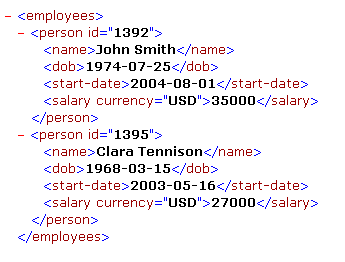- As XML documents provide structured data storage, many people see a need for database-style query languages which provide complex ways to access the data. Such languages are used to get data, as small as the text of a single tag, then group results to create reports or compute answers to questions such as 'how many widgets did we sell in March?'
- There has been enormous activity in querying xml in the database community. W3C has come out with XQuery and is being implemented by major players. This tool is being developed as a front end to generate basic queries so that end users.
Applies to: SQL Server (all supported versions)
Specifies an XQuery against an instance of the xml data type. The result is of xml type. The method returns an instance of untyped XML.
XSet is an XML database and high performance search engine library with a very simple tag-oriented query language, expressed in XML itself. UC Berkeley's Cheshire system indexes and searches structured data including XML, SGML and MARC records, as well as full-text data files.
Syntax
Note
To view Transact-SQL syntax for SQL Server 2014 and earlier, see Previous versions documentation.
Arguments
XQuery
Is a string, an XQuery expression, that queries for XML nodes, such as elements and attributes, in an XML instance.
Examples
This section provides examples of using the query() method of the xml data type.
A. Using the query() method against an xml type variable
The following example declares a variable @myDoc of xml type and assigns an XML instance to it. The query() method is then used to specify an XQuery against the document.
The query retrieves the <Features> child element of the <ProductDescription> element:
The following output shows the result:
B. Using the query() method against an XML type column
In the following example, the query() method is used to specify an XQuery against the CatalogDescription column of xml type in the AdventureWorks database:
Note the following items from the previous query:
Xml Query Tool Microsoft

The CatalogDescription column is a typed xml column, which means it has a schema collection associated with it. In the XQuery Prolog, the namespace keyword defines the prefix that's later used in the query body.
The query() method constructs XML, a <
Product> element that has a ProductModelID attribute, in which the ProductModelID attribute value is retrieved from the database. For more information about XML construction, see XML Construction (XQuery).The exist() method (XML data type) in the WHERE clause finds only rows that contain the <
Warranty> element in the XML. Again, the namespace keyword defines two namespace prefixes.
The following output shows the partial result:
Note the query() and exist() methods both declare the PD prefix. In these cases, you can use WITH XMLNAMESPACES to first define the prefixes and use it in the query.
See Also
Add Namespaces to Queries with WITH XMLNAMESPACES
Compare Typed XML to Untyped XML
Create Instances of XML Data
xml Data Type Methods
XML Data Modification Language (XML DML)
This online tool allows you to test your XPath expressions / queries against an XML string or file. You can easily debug your XPath expressions!
This utility also includes an XPath generator that helps you easily create XPath expressions. Double click (In 'Your XML string' editor) the element, attribute, or text you want to generate the associated xpath expression.
You can see example XPath expression to help you to find your Xpath query.
You can see the user guide to help you to use this XPath tester.
User guide
In order to test your XPath expression, you must:
- Fill 'Your XPath expression' editor
- Fill 'Your XML string' editor
Xml Query Tool Online
To fill 'Your XML string' editor, you can:
- Copy and paste your XML string
- Drag and drop your XML file
- Click on 'Browse XML file' button in order to load your XML file
- Directly type your XML string in the editor
To generate an XPath expression:
Just double click on the element, attribute, or text you want to generate the Xpath expression.
This tool does not support the XPath functions (number(), string(), string-length() ...).
About XPath
XML Path Language (XPath) is a query language for selecting nodes from a XML data. Xpath can be used to query XML databases.
It is based on a tree representation of the XML, it allows to navigate through elements in an XML document.
XPath uses path expressions to select nodes in an XML document.
Xml Query Tool Photoshop
XPath expressions can be used in many programming languages (JavaScript, Java, PHP, Python, C, ...).
Xml Query Tool
XPath is a W3C recommendation.
XPath Examples
| Select the tools element | /tools |
| Select all tool elements which are direct children of the tools element | /tools/tool |
| Select all tool elements without taking into account the tree | //tool |
| Select the second tool element | //tool[position() = 2] |
| Select the value attribute of all tool elements without taking into account the tree | //tool/@value |
| Select the tool element which has the id attribute value of 1 | //tool[@id=1] |
This tool uses document.evaluate function to test your XPath query.
Comments are closed.